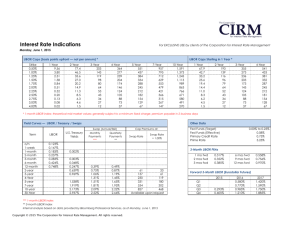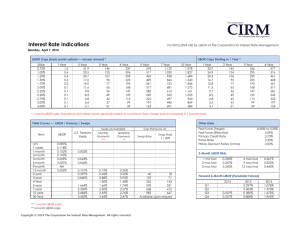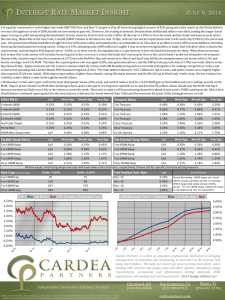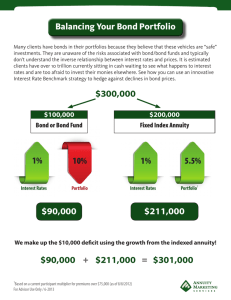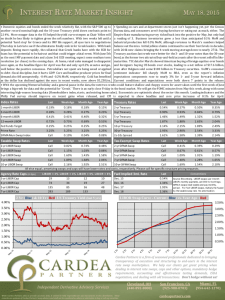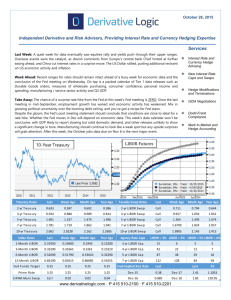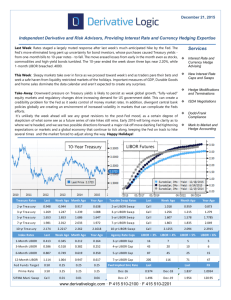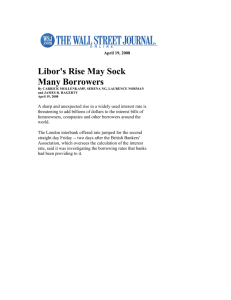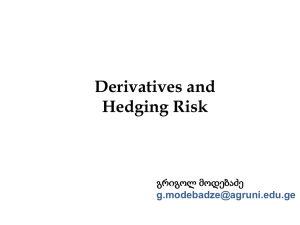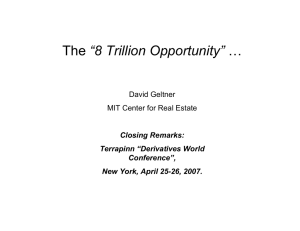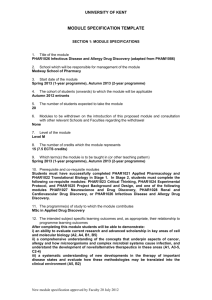the learning curve aug08.qxd
advertisement
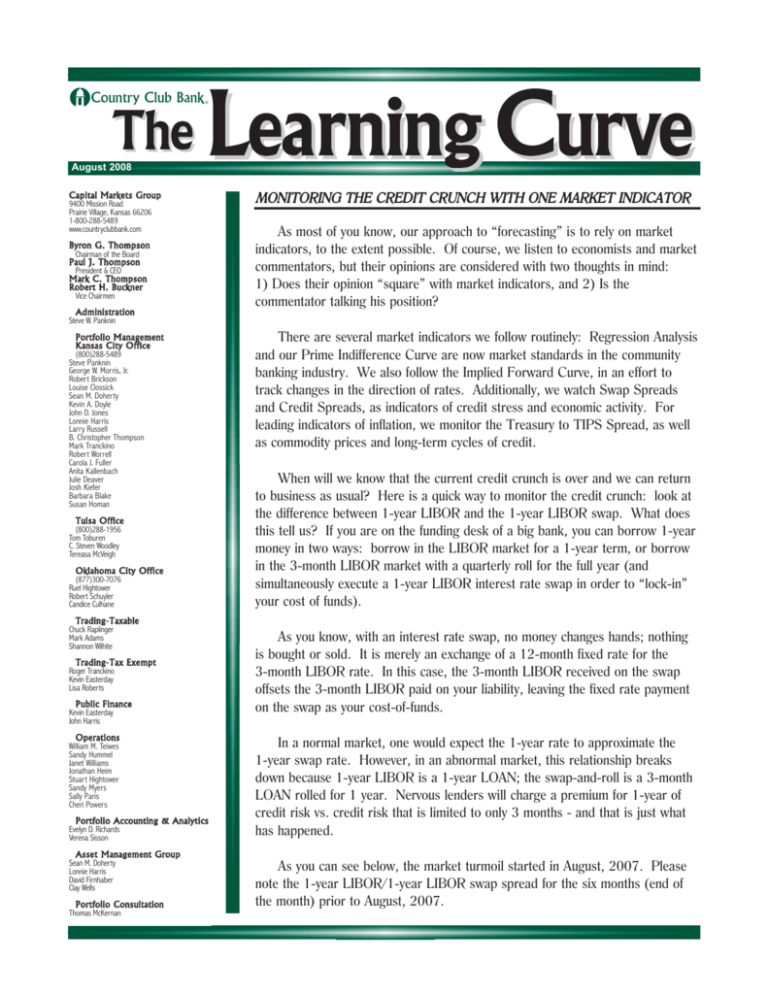
The
Lear ning Cur ve
{Country Club Bank~
August 2008
Capital Markets Group
9400 Mission Road
Prairie Village, Kansas 66206
1-800-288-5489
www.countryclubbank.com
Byron G. Thompson
Chairman of the Board
Paul J. Thompson
President & CEO
Mark C. Thompson
Robert H. Buckner
Vice Chairmen
Administration
Steve W. Panknin
Portfolio Management
Kansas City Office
(800)288-5489
Steve Panknin
George W. Morris, Jr.
Robert Brickson
Louise Clossick
Sean M. Doherty
Kevin A. Doyle
John D. Jones
Lonnie Harris
Larry Russell
B. Christopher Thompson
Mark Tranckino
Robert Worrell
Carola J. Fuller
Anita Kallenbach
Julie Deaver
Josh Kiefer
Barbara Blake
Susan Homan
Tulsa Office
(800)288-1956
Tom Toburen
C. Steven Woodley
Tereasa McVeigh
Oklahoma City Office
(877)300-7076
Ruel Hightower
Robert Schuyler
Candice Culhane
Trading-T
Taxable
Chuck Raplinger
Mark Adams
Shannon Wilhite
Trading-T
Tax Exempt
Roger Tranckino
Kevin Easterday
Lisa Roberts
Public Finance
Kevin Easterday
John Harris
Operations
William M. Teiwes
Sandy Hummel
Janet Williams
Jonathan Heim
Stuart Hightower
Sandy Myers
Sally Paris
Cheri Powers
Portfolio Accounting & Analytics
Evelyn D. Richards
Verena Sisson
Asset Management Group
Sean M. Doherty
Lonnie Harris
David Firnhaber
Clay Wells
Portfolio Consultation
Thomas McKernan
MONITORING THE CREDIT CRUNCH WITH ONE MARKET INDICATOR
As most of you know, our approach to “forecasting” is to rely on market
indicators, to the extent possible. Of course, we listen to economists and market
commentators, but their opinions are considered with two thoughts in mind:
1) Does their opinion “square” with market indicators, and 2) Is the
commentator talking his position?
There are several market indicators we follow routinely: Regression Analysis
and our Prime Indifference Curve are now market standards in the community
banking industry. We also follow the Implied Forward Curve, in an effort to
track changes in the direction of rates. Additionally, we watch Swap Spreads
and Credit Spreads, as indicators of credit stress and economic activity. For
leading indicators of inflation, we monitor the Treasury to TIPS Spread, as well
as commodity prices and long-term cycles of credit.
When will we know that the current credit crunch is over and we can return
to business as usual? Here is a quick way to monitor the credit crunch: look at
the difference between 1-year LIBOR and the 1-year LIBOR swap. What does
this tell us? If you are on the funding desk of a big bank, you can borrow 1-year
money in two ways: borrow in the LIBOR market for a 1-year term, or borrow
in the 3-month LIBOR market with a quarterly roll for the full year (and
simultaneously execute a 1-year LIBOR interest rate swap in order to “lock-in”
your cost of funds).
As you know, with an interest rate swap, no money changes hands; nothing
is bought or sold. It is merely an exchange of a 12-month fixed rate for the
3-month LIBOR rate. In this case, the 3-month LIBOR received on the swap
offsets the 3-month LIBOR paid on your liability, leaving the fixed rate payment
on the swap as your cost-of-funds.
In a normal market, one would expect the 1-year rate to approximate the
1-year swap rate. However, in an abnormal market, this relationship breaks
down because 1-year LIBOR is a 1-year LOAN; the swap-and-roll is a 3-month
LOAN rolled for 1 year. Nervous lenders will charge a premium for 1-year of
credit risk vs. credit risk that is limited to only 3 months - and that is just what
has happened.
As you can see below, the market turmoil started in August, 2007. Please
note the 1-year LIBOR/1-year LIBOR swap spread for the six months (end of
the month) prior to August, 2007.
The Learning Curve
August 2008
Feb 07
Mar 07
Apr 07
May 07
Jun 07
Jly 07
Aug 07
LIBOR
5.23813%
5.22000%
5.29500%
5.39000%
5.38000%
5.24500%
5.27500%
Page 2
LIBOR SWAP
5.241%
5.244%
5.2985%
5.395%
5.377%
5.2549%
5.0915%
In August, the spread widened by 18 basis points and has remained in the range of 20-25 basis points ever
since. During this period, write-offs and write-downs from subprime loans and other credit spread product have
totaled almost a half of trillion dollars. FNMA and FHLMC have been bailed out; Bear Stearns and IndyMac are
gone and the future of FDIC is suspect. Countrywide, the nation’s largest mortgage lender, has been merged into
Bank of America; Washington Mutual, the nation’s largest thrift, is on life support; and Lehman Brothers is the
subject of constant rumors. When will it stop?
Of course, the ultimate answer is that it stops when all of us save more and spend less. In the short run,
however, the market will tell us when it’s over - when the 1-year LIBOR and the 1-year LIBOR swap resume their
normal relationship. We’re not there yet. This morning (July 30, 2008), the spread is 20 bps (3.28750% less
3.086%) - not even close.
We like to think that our basic investment philosophy has been vindicated – that minimizing credit risk in the
bond portfolio will ultimately maximize the return on equity. Most financial intermediaries have more than enough
credit risk in the loan book anyway. Additionally, riskier bonds require an 8% capital ratio and can suffer a
significant impairment of marketability. Recognizing that quality begets liquidity, we’ve always believed our
fixed-income clients are better served by securities with slightly less yield and substantially more liquidity. With
respect to municipals, we’ve never relied entirely on rating agencies and insurance companies, having always
examined the underlying credit of the bonds we position and promote.
Better to learn from the mistakes of others.
Tom McKernan
Senior Vice President
The information herein was obtained from sources which Country Club Bank and our suppliers believe reliable, but we do not guarantee accuracy.
Neither the information, nor any opinion expressed, constitutes a solicitation to buy or sell securities.
The products offered (1) are not FDIC insured, (2) are not deposits or other obligations of the bank or guaranteed by the bank,
and (3) involve investment risks, including possible loss of principal amount invested.
